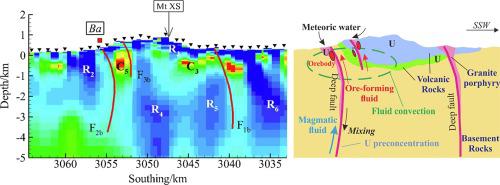当前位置:
X-MOL 学术
›
Ore Geol. Rev.
›
论文详情
Our official English website, www.x-mol.net, welcomes your
feedback! (Note: you will need to create a separate account there.)
Ore-controlling structures of the Xiangshan Volcanic Basin, SE China: Revealed from Three-Dimensional Inversion of Magnetotelluric Data
Ore Geology Reviews ( IF 3.2 ) Pub Date : 2020-12-01 , DOI: 10.1016/j.oregeorev.2020.103807 Juzhi Deng , Hui Yu , Hui Chen , Zhijun Du , Haiyan Yang , Hongxing Li , Shangping Xie , Xiao Chen , Fusheng Guo
Ore Geology Reviews ( IF 3.2 ) Pub Date : 2020-12-01 , DOI: 10.1016/j.oregeorev.2020.103807 Juzhi Deng , Hui Yu , Hui Chen , Zhijun Du , Haiyan Yang , Hongxing Li , Shangping Xie , Xiao Chen , Fusheng Guo

|
Abstract We report a high-resolution three-dimensional (3D) Magnetotelluric (MT) study to define the mineralizing system of the Xiangshan (XS) volcanic Basin, which hosts the largest volcanic-related uranium deposits in China. MT data from 81 stations were collected and inverted, using a 3D Truncated Newton (TRN) inversion algorithm. The generated electrical resistivity model reveals a high resistivity layer in the shallow, followed by a conductivity layer, and they were formed respectively by the Cretaceous Ehuling Formation and Daguding Formation. Under these Cretaceous formations, a series of high resistivity features delineate the Precambrian metamorphic basement. The contact zone between the high resistivity and conductivity layer corresponds to the inter-formational surface in the Cretaceous volcanic cover, whereas the contact zone between the volcanic cover and metamorphic basement represents the unconformity surface which was supported by gravity data. The identified faults in the 3D resistivity model coincide with the NE- and NS-trending faults observed on the surface. These faults are the crucial ore-controlling structures with high permeability allowing the ore-forming fluids to migrate upwards. We reveal a possible genetic model for the uranium mineralization in the XS volcanic Basin. The mixture of the descending meteoric water and ascending magmatic fluids along the deep faults formed the ore-forming fluids. The precipitation and enrichment of uranium were prone to occur in the ring faults, interfaces, unconformity surfaces and those geologic contacts intersecting with faults, where the physical and chemical properties of the ore-forming fluids were changed. Given that the mafic magmatism generally was coeval with the uranium mineralization, the deep-seated magmatism is supposed to be the force that drove the fluids upwards and governed the circulative convection of ore-forming fluids in the XS volcanic Basin.
更新日期:2020-12-01











































 京公网安备 11010802027423号
京公网安备 11010802027423号